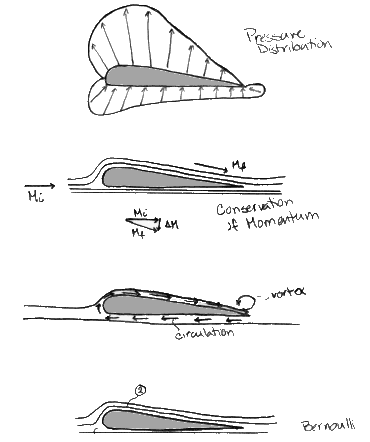|
|
The Physics of Space Shuttle Re-Entry Page 2 How Does the Shuttle Fly? After the shuttle has slowed down in the atmosphere it must "fly" or "fall with style" to the airport where it will land. To make this possible the shuttle is designed like an airplane; therefore, aerodynamics are a large part of the engineering that goes into the design of the shuttle. The main reason that airfoils work is because of Newton's Third Law: for every action force there is an equal and opposite reaction force. In layman's terms, this means that for every unit of force that the airfoil is pushing down on the air, the air is pushing back with the same force. This resistive force is what supports the weight of the aircraft on the airfoil. These diagrams show how the pressure is distributed as described by Bernoulli's equation (Po = P1 + ½rV1² + rgy1 = P2 + ½rV2² + rgy2). Po=Stagnation Pressure [Pa] or [lbf/ft2]
His equation, simply worded, says that when an object is moving through a fluid, the faster the fluid moves over the surface, the less the pressure on the surface. This means that if the fluid (air in this case) moves faster over the top of the foil then there is more pressure on the bottom than on the top.
More pictures and information at http://web.mit.edu/2.972/www/reports/hydrofoil/hydrofoil.html Another equation that applies to the lift produced by airfoils is Euler's Equation (d(p+rgy)/dn = rV²/R). P=Pressure [Pa] or [lbf/ft2] This equation says that as you go further
from the center of the radius of curvature of a streamline, the pressure
on the streamlines increases. The upper surface of the foil is closer
to the center of curvature of the streamlines, therefore there will
be a lower pressure than the ambient pressure above the foil. The
difference between the pressure on the top surface and the ambient
pressure at the bottom surface will produce a net pressure that will
cause the lift (Tina Rosado).
More pictures and information at http://web.mit.edu/2.972/www/reports/hydrofoil/hydrofoil.html Why Does the Shuttle Create So Much Heat on Re-Entry? The heat that the shuttle creates is mostly due to the pressure wave that the shuttle creates in front of it as it moves at extreme speeds into the atmosphere. It is commonly thought that this heat is due to friction but the heat caused from friction is really not what causes the extreme temperatures on the shuttle. The Ideal Gas Law shows where the extreme temperatures come from. PV=nRT As the pressure increases, the temperature must increase also to balance the equation. The volume does change, but not enough to compensate for the dramatic increase in pressure. The temperatures become so extreme that they facilitate in creating a plasma in front of the shuttle as it is "falling" through the atmosphere. This heat/plasma is a problem for the space shuttle if it got into the structure of the space craft. The plasma would simply melt the space shuttle if it could find a way to get into it. The rate of energy transfer (P) through substance is shown in the equation below. P = kA(T2-T1)/L Where k is the thermal conductivity, A is the cross sectional area of the contact area of the substance in question, T2 and T1 are temperatures on the opposite sides of the substance and L is the thickness of the substance. Heat flow into the structure of the shuttle is minimized by heat resistive tiles that cover the entire bottom of the shuttle. These tiles have an extremely low thermal conductivity. An example of a substance with a low thermal conductivity is asbestos (0.08W/mC). Metals, such as gold, have high thermal conductivities (gold = 314W/mC).
|

